The stock market is adapting to a new macro situation, wherein the leading perception is that the U.S. economy is recovering from the COVID pandemic. The Federal Reserve continues to downplay the inflationary side effect of its policies as its own Beige Book is full of anecdotal evidence of its existence. Specifically, the Fed's ongoing diary of the economy has multiple examples and comments documenting the fact that there are inflationary pressures building in a number of supply chains for producers and businesses. There is also building statistical evidence which shows that inflation continues to build in the housing market and the grocery store.
As a result of these converging influences, we've seen increasing volatility in both the stock and bond markets. Nevertheless, the overriding influence on stocks remains the Fed's continuation of its QE, which puts $120 billion per month into the bond market with much of that money making its way into stocks.
Moreover, in this market, success depends on which stocks you own and not necessarily which stocks are in the news. What that means is that, with many high-profile tech stocks selling off, the Fed's QE liquidity needs to go somewhere - and, for all practical purposes, that money is moving into a variety of sectors and companies which are usually overlooked by the markets. The driving theme shared by stocks that are breaking out are those companies which actually make money, such as those who provide:
- Industrial processes
- Applied technology, and
- Energy
Ironically, we may be entering an era where sexy tech is out and stocks with a working theme, rolled-up sleeves, are in.
Bond Yields Enter Consolidation Pattern
As would be expected once the market became focused on rising bond yields, a phenomenon we described and traded successfully for weeks ahead of it being widely noted, U.S. treasuries have entered a consolidation pattern within the broad yield band of 1.2 to 1.6% on the U.S. Ten Year Note yield (TNX). Still, even if yields continue to move sideways for the next few weeks to months, because of the broad trading range, we could still see a good deal of intermarket volatility result.
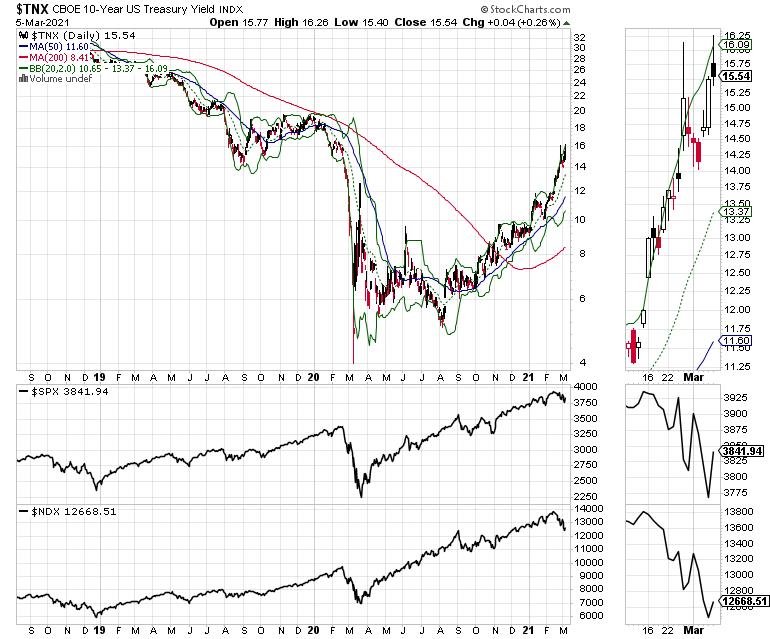
Meanwhile, as the chart above illustrates, this volatility in the bond market and the accompanying uncertainty that it's creating is having a negative effect on the major indexes (NDX and SPX), but, as I will discuss below, not necessarily on all individual stocks. Moreover, when we examine the relationship between the U.S. 30-Year Bond yield (TNX) and the same stock indexes, two things emerge:
- The trading range in TYX is narrower than that of TNX
- TNX made a more dramatic high in yields than TYX
- We may have seen a top in yields for the short-term
- We may be entering a consolidation pattern in bonds
Moreover, it's important to keep these two important concepts in mind: 1) TNX is seen as an economic variable since mortgage rates are based on its action, while 2) TYX is seen a gauge of future inflation.
As a final thought, I will add that TNX made a new high to end last week, but TYX did not. That may or may not be a meaningful divergence, but it is worth watching. Perhaps the whole thing can best be summarized by the fact that money continues to move out of the bond market as stocks rise, which suggests that bond traders are still deploying money into stocks, at least some of the time.
Have you thought about where to invest as bond yields fluctuate? Find out with a Free Trial to my service (click here).
The New Sexy: Oracle Breaks Out as Tesla Slumps
Tech investors have taken a bath of late, with market darlings such as Tesla (TSLA) rolling over in the last few days. Meanwhile, those of us who bothered to look beyond the Nasdaq mainstream found that shares of "legacy" IT giant Oracle (ORCL) were gathering steam, with the eventual breakout coming on March 5.
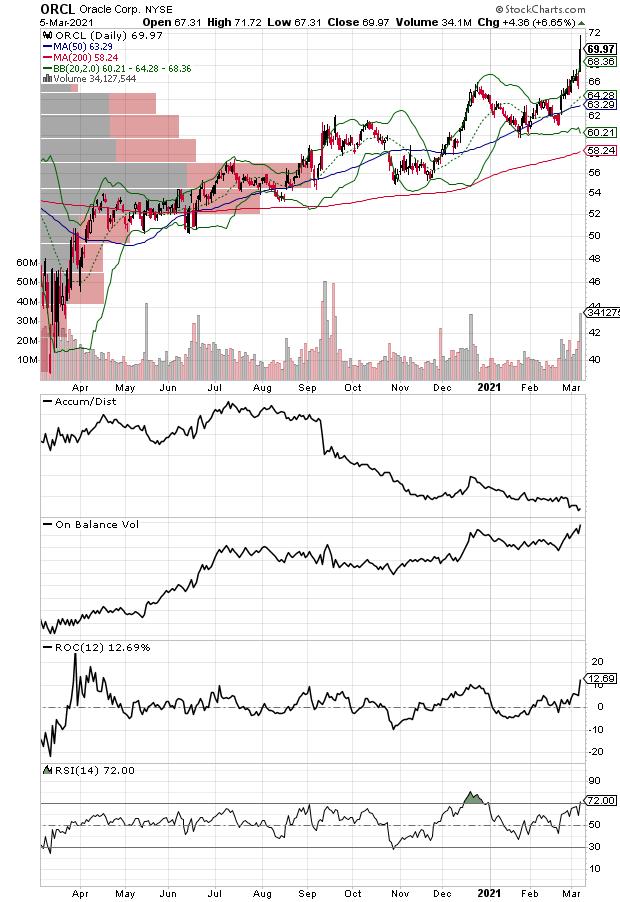
Now, I have to be honest. Oracle is one of those companies that makes money hand over fist and has been doing so for decades. Witness how its founder Larry Ellison quietly moved to Hawaii and now spends most of his time sponsoring tennis tournaments, at least prior to COVID cancelling his favorite ATP tour stop at Indian Wells. Moreover, Oracle's problem has always been that, even though it makes money, it usually disappoints analyst expectations, which is why the stock often goes nowhere - except for lately.
In fact, the stock jumped well out of its recent trading range on 3/5/21 ahead of its 3/10/21 earnings on an analyst upgrade, which cited Oracle's cloud business as being overlooked by investors while raising expectations for a results beat as well as upbeat guidance. Of course, we'll see if this actually pans out.
Nevertheless, much of the bullishness about ORCL these days is based on the performance of their Fusion ERP (Enterprise Resource Planning) cloud software, a program which integrates a company's finances, HR, supply chain and customers' needs and experience and allows the visualization of all aspects of operations to be viewed at once. What it all boils down to is that the bullishness may be justified as Fusion and Oracle's cloud services are growing rapidly. This is something which may have increased during the most recent COVID phase, where companies required the ability to look at all parts of their businesses in an integrated fashion more urgently in order to adjust to the rapidly changing landscape.
In fact, in the company's November 2020 earnings call, CEO Safra Catz and Chairman Larry Ellison noted:
- Earnings and revenues likely to continue to continue to grow as cloud service expands;
- Subscription revenues were $2.9 billion, up 5%, with strategic back-office applications up 26%, including Fusion ERP, which was up 33%; NetSuite ERP, up 20%; and Fusion HCM, up 24%;
- Retention rates for strategic back-office cloud applications rose;
- The company is having to build numerous data centers in order to meet demand for service, and
- Oracle expects high profile customers to leave their competition aggressively, which will increase market share.
The stock may consolidate ahead of earnings. And, of course, ORCL being ORCL, the shares could tank after the results, regardless of how good they are as the algos are hard to predict. Certainly it would be nice to see the Accumulation Distribution (ADI) and On Balance Volume (OBV) improve also. But there is little overhead resistance at these levels, with good support at $64-$66. Thus, even if the price pulls back, the odds of a nice rebound are above average if the earnings report delivers a big surprise.
I own ORCL as of this writing. For more stocks like ORCL and recent winners such as AIT, consider a FREE trial to Joe Duarte in the Money Options.com (click here).
NYAD Survives after Briefly Dipping into Sell Signal Territory
The New York Stock Exchange Advance Decline line (NYAD) is still consolidating after a multi-week run to new highs, which ended in mid-February. But, on the bright side, the key indicator managed to survive a near sell signal on 3/5/21 as it dipped just below the 50-day moving average while the RSI remained below 50. Thankfully, the double dip sell signal was temporary, although there is no guarantee that a sell signal won't materialize in the near future.
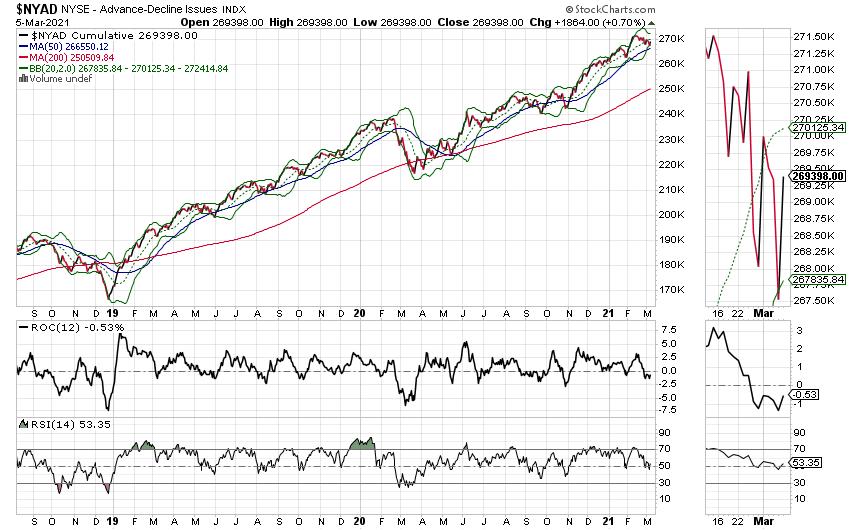
So, for now, NYAD gets the benefit of the doubt. Still, we've had no new high on NYAD for the past couple of weeks, which is a concern, although this is balanced by the lack of a sell signal. Remember, as long as NYAD continues to make new highs, remains above its 50- and 200-day moving averages and its corresponding RSI reading remains above 50, the trend is up. This combined set of observations has been extremely reliable since 2016. Currently, NYAD is still in a long-term uptrend.
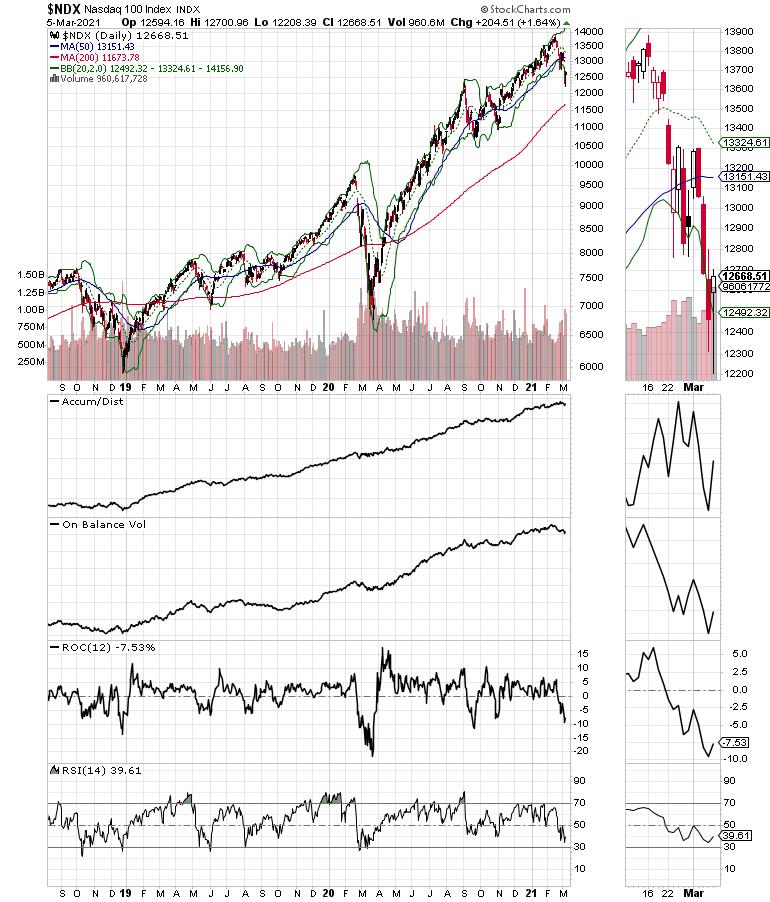
But not all parts of the market were lucky as the Nasdaq 100 (NDX), which met with heavy selling in large cap tech names and drove the index into a short-term Chaos Zone below its 50-day moving average. The silver lining on NDX is that it is reaching an oversold reading on RSI, so a bounce is likely, although the quality of the bounce is what matters most.
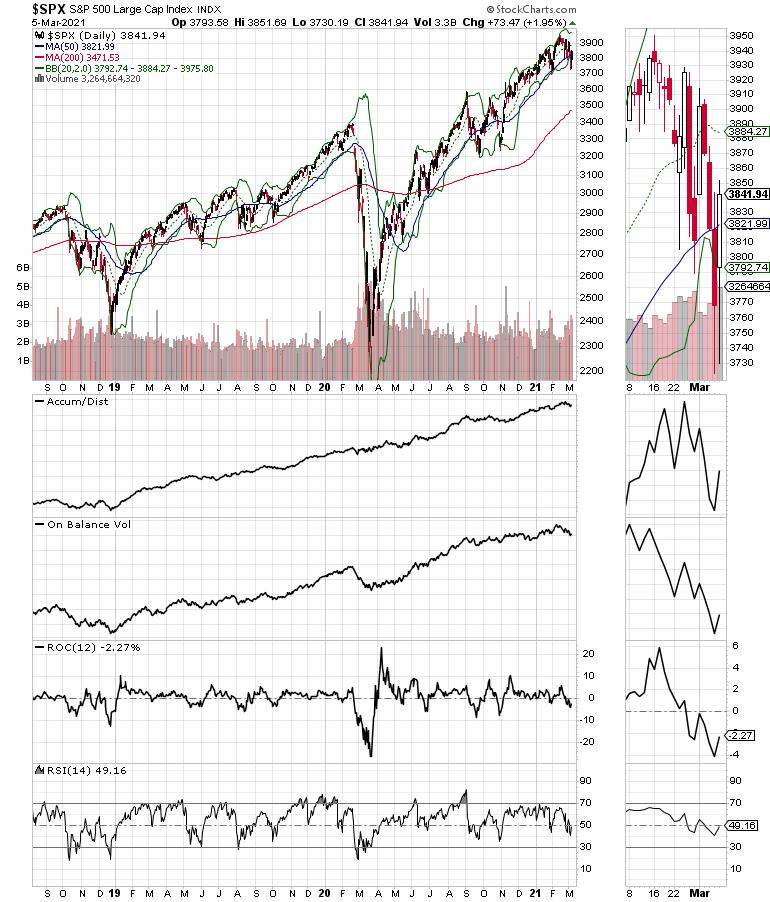
Meanwhile the S&P 500 (SPX) survived its own dip below the key technical support level, with its own RSI surviving a test of the 50 area. Also positive is the fact that SPX remained above its recent short-term low, near 3700.
Rotation Theme Evolves
As I noted last week, the volatility in bond yields seems to be creating confusion in the stock market. And with tech stocks selling off, the Fed's money needs to somewhere, which means that stocks out of the mainstream are now ripe for positive money flows.
In other words, the best way to manage this market is to stick with sound trading rules and watch each individual position as it relates to the general trend in the market. And, in this case, the big rule is to look for stock prospects with emerging uptrends in sectors which have been lagging.
For more on how to deal with the current market, check out my latest Your Daily Five video here. For more details on bonds, currencies, and stocks, check out my recent interview with Wall Street Reporter.com here.
Joe Duarte
In The Money Options
Joe Duarte is a former money manager, an active trader and a widely recognized independent stock market analyst since 1987. He is author of eight investment books, including the best selling Trading Options for Dummies, rated a TOP Options Book for 2018 by Benzinga.com and now in its third edition, plus The Everything Investing in Your 20s and 30s Book and six other trading books.
The Everything Investing in Your 20s and 30s Book is available at Amazon and Barnes and Noble. It has also been recommended as a Washington Post Color of Money Book of the Month.
To receive Joe's exclusive stock, option and ETF recommendations, in your mailbox every week visit https://joeduarteinthemoneyoptions.com/secure/order_email.asp.
